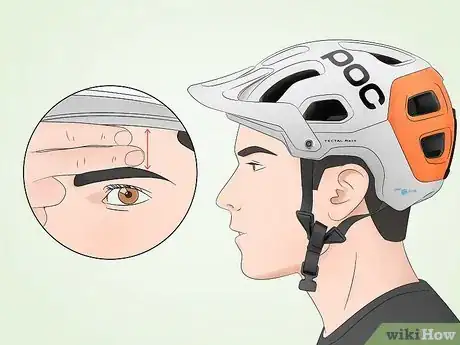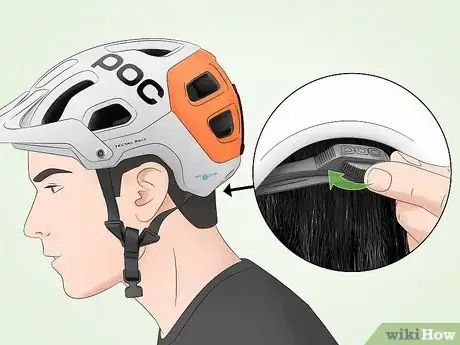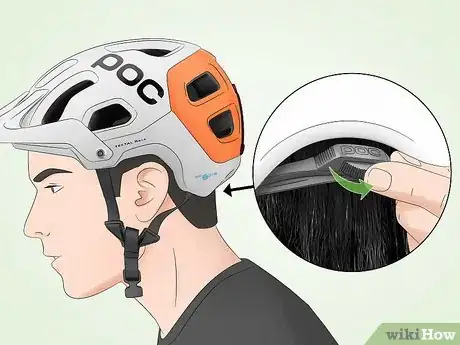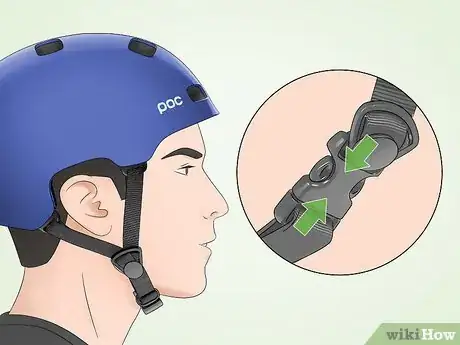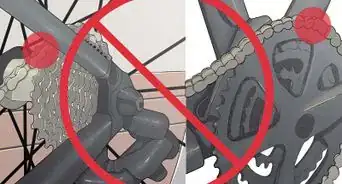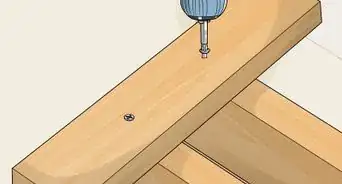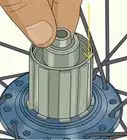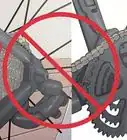This article was co-authored by wikiHow staff writer, Hunter Rising. Hunter Rising is a wikiHow Staff Writer based in Los Angeles. He has more than three years of experience writing for and working with wikiHow. Hunter holds a BFA in Entertainment Design from the University of Wisconsin - Stout and a Minor in English Writing.
There are 15 references cited in this article, which can be found at the bottom of the page.
This article has been viewed 19,440 times.
Learn more...
POC is a Swedish brand that makes top-of-the-line bicycle helmets that offer more rigid protection than others. Even though you have to select a helmet that fits your head, there still may be minor adjustments you need to make so you stay safe. Luckily, POC helmets use the same style retention systems, which are the interior straps that hold the helmet tightly against your head, and straps as many other helmets so it will be easy for you to make your changes. Some models may also let you move the visor so you can position it depending on the sun. After you make your adjustments, you’ll be able to ride your bike safely!
Steps
Securing the Retention System
-
1Put the helmet on so it sits 1–2 finger-widths above your eyebrows. Set your helmet on your head and push it down as far as it can go. Hold your index and middle finger up against your forehead so they’re just above your eyebrows. Tilt the front of the helmet with your dominant hand until you feel the edge of the helmet touch your fingers. Keep your helmet in this position while you adjust the retention system.[1]
-
2Turn the back retention dial clockwise to tighten the helmet’s fit. Hold the helmet in place with your nondominant hand so it doesn’t move around. Reach around to the back of the helmet with your dominant hand and locate the dial along the bottom edge. If the helmet doesn’t fit snugly, use your thumb to spin the dial clockwise to move the retention system closer toward the back of your head.[2]
- While you can make your adjustment with the helmet off, it will be easier to feel how tight it is if you’re wearing it.
Advertisement -
3Rotate the dial counterclockwise to make the helmet looser. If the retention system feels too tight or gets uncomfortable over time, try spinning the dial counterclockwise instead. The retention system will move further away so it doesn’t apply pressure to the back of your head.[3]
- Avoid loosening the retention system so much that the helmet rocks back and forth since it will easily fall off and won’t offer much protection.
Variation: Your helmet may have 2 clips that you need to squeeze together instead of a dial. Hold the clips together so you can push or pull the retention system closer or further from your head.
-
4Adjust the dial until the helmet stays still when you shake your head. Continue turning the dial until you feel the retention system press against the back of your head without feeling uncomfortable. Let go of the helmet and shake your head back and forth to see if the helmet rocks from side to side. If it does, continue tightening it until it stays in place.[4]
- If you’ve already turned the retention system dial as far as it can go, you may have an improperly-sized helmet and need to buy a new one that fits properly.
Tightening the Chin Straps
-
1Wear your helmet so it’s low on your forehead. Put your helmet on and pull it down tightly onto your head. Place 2 fingers against your forehead so they’re just above your eyebrows. Use your other hand to tilt the helmet down until you feel the bottom edge touch your fingers. Always wear your helmet in this position to properly protect your head in case of an accident.[5]
- If you wear your helmet higher on your head, you may be more vulnerable to injuries if you get into an accident.
-
2Move the side sliders until the straps form V-shapes under your ears. Locate where the straps connect to the side of the helmet and follow them down to where they intersect, which will have a plastic slider. Hold onto the strap that’s closest to the back of the helmet with your nondominant hand. Grip the plastic slider with your other hand and pull it forward until it sits comfortably just underneath your ear. Move the slider on the other side of your helmet so it’s also under your ear.[6]
- Try to position the side straps the same distance forward on each side, or else your helmet may sit crooked on your head.
Variation: Some POC helmets do not have adjustable side sliders, so you will not be able to adjust them.[7]
-
3Buckle your helmet under your chin. Follow the straps on each side of the helmet down to the plastic buckle. Bring the buckles underneath your chin and push the pronged end into the open end until you hear them click together. It’s okay if the strap feels loose right now as long as it clips underneath your chin.[8]
-
4Pull the chin strap until you can only fit 2–3 fingers between it and your chin. Locate the plastic slider with straps running through it just behind the buckle. Hold onto the plastic slider with 1 hand and pull the loose end of the strap with the other. Keep pulling the chin strap until it sits against your chin. Try sliding 3 fingers between the strap and your chin and push down on the strap. If it doesn’t move, then the strap is tight enough. Otherwise, you may need to tighten it more.[9]
- If you have a lot of excess strap hanging down after tightening the helmet, use scissors to the cut the strap so it hangs down by about 1–2 inches (2.5–5.1 cm).
- If you need to loosen the strap, pull the strap that’s looped through the slider and move it further away from the buckle.
Changing the Visor Height
-
1Turn the dial in the middle of the visor counterclockwise to loosen it. Look for the small circular dial attached to the helmet’s shell in the middle of the visor. Grip the dial and spin it counterclockwise until the visor moves around without any resistance.[10]
- You don’t have to wear your helmet when you adjust the visor.
- Not all POC helmets have a visor.
-
2Raise or lower the visor to block the sun. The height you set your visor depends on personal preference and how much you want to block the sun. Simply grab the sides of the visor and tilt it up if you want the visor up and out of the way. Otherwise, you can lower it so it’s level with the front of your helmet to block the most light. When you’re happy with the position, hold the visor in place so it doesn’t move around.[11]
- For example, on an overcast day, you may want to raise your visor so you can see your surroundings better. On a very sunny day, you can drop your visor back down.
-
3Rotate the dial clockwise to secure the visor in place. Keep holding the visor in place so it doesn’t drop down before you can tighten it. Use your other hand to turn the dial clockwise until you feel resistance so the visor locks into position. After that, you can let go of your visor and start riding![12]
Warnings
References
- ↑ http://www.ndhealth.gov/injury/publications/Easy%20Steps%20to%20Properly%20Fit%20A%20Bicycle%20Helmet.pdf
- ↑ https://youtu.be/tWEkNZhwt7Q?t=136
- ↑ https://youtu.be/DF7PQQ8fo7E?t=63
- ↑ https://www.nhtsa.gov/sites/nhtsa.dot.gov/files/8019_fitting-a-helmet.pdf
- ↑ https://www.nhtsa.gov/sites/nhtsa.dot.gov/files/8019_fitting-a-helmet.pdf
- ↑ https://blisterreview.com/gear-reviews/poc-crane-helmet
- ↑ https://cyclingtips.com/2018/03/poc-ventral-helmet-review/
- ↑ http://www.ndhealth.gov/injury/publications/Easy%20Steps%20to%20Properly%20Fit%20A%20Bicycle%20Helmet.pdf
- ↑ https://youtu.be/IyhyrITHDgw?t=80
